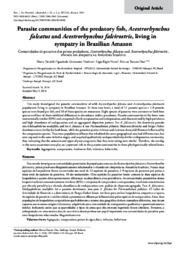Parasite communities of the predatory fish, Acestrorhynchus falcatus and Acestrorhynchus falcirostris, living in sympatry in Brazilian Amazon.
Parasite communities of the predatory fish, Acestrorhynchus falcatus and Acestrorhynchus falcirostris, living in sympatry in Brazilian Amazon.
Author(s): HOSHINO, M. D. F. G.; NEVES, L. R.; TAVARES-DIAS, M.
Summary: This study investigated the parasite communities of wild Acestrorhynchus falcatus and Acestrorhynchus falcirostris populations living in sympatry in Brazilian Amazon. In these two hosts, a total of 12 parasite species e 1-9 parasite species were found per fish, and 10 of these species are metazoans. Eight species of parasites were common to both host species and four of them exhibited differences in abundance and/or prevalence. Parasite communities of the hosts were taxonomically similar (83%) and composed of both ectoparasites and endoparasites, and characterized by high prevalence and high abundance of endoparasites and an aggregated dispersion pattern. For A. falcirostris, the dominant parasite was Ichthyophthirius multifiliis, and for A. falcatus, it was Piscinoodinium pillulare. Shannon diversity and Berger-Parker dominance were similar for both hosts, while the parasites species richness and evenness showed differences influenced by the ectoparasites species. These two populations of hosts that inhabited the same geographical area had different sizes, but were exposed to the same infective stages, and acquired qualitatively and quantitatively similar endoparasites community, thus indicating that the amounts and types of prey congeneric that they were eating were similar. Therefore, the overlap in the same occurrence area play an important role in the parasite communities to these phylogenetically related hosts.
Publication year: 2016
Types of publication: Journal article
Unit: Embrapa Amapá
Observation
Some of Embrapa's publications are published as ePub files. To read them, use or download one of the following free software options to your computer or mobile device. Android: Google Play Books; IOS: iBooks; Windows and Linux: Calibre.
Access other publications
Access the Agricultural Research Database (BDPA) to consult Embrapa's full library collection and records.
Visit Embrapa Bookstore to purchase books and other publications sold by Embrapa.

